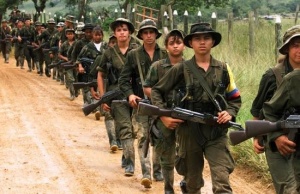
Guerrilla Warfare in Latin America

When a nation is invaded, or succumbs to an authoritarian government, its people usually are no match for either foreign or national military; these well trained troops would likely defeat them on a battlefield. However, as the road toward victory using conventional warfare is blocked, a side road featuring unconventional guerilla warfare can open. Many revolutions and resistance movements have used these side roads and more unconventional tactics to achieve great success. They paved the way for Yugoslavia’s President for almost the entirety of the Cold War, created chaos for the Colombian government, and even challenged the great military mastermind of Napoleon.
Guerrilla warfare, or unconventional war, occurs when a small group of combatants use military tactics such as sabotage, raids, landmines, and hit-and-run operations, to fight a traditional and often less mobile conventional army. Their aim is not only to kill enemy troops, but to attack the psyche and moral ensuring the enemy or oppressive government understands that they may occupy the territory, but they will not be able to control it. After they strike, guerrilla forces often go back to their hiding place, and wait for the next attack. This type of warfare is successful in irregular terrain, thick forests, caves, or hills which provide cover and places to hide.
Historically the tactic has been successful against more well-trained larger armies. The Roman Empire struggled with the hit and run tactics of Germanic Tribes, the Crusaders struggled against the lighter equipped mamelukes, and Napoleon suffered during the Peninsular War, between 1807 and 1814. More recently, during World War II the Nazis faced guerrilla tactics from local resistance in the Western Front, with an honorable mention to the French Resistance that was crucial for the operation of D-Day, and by Partisans in the Eastern Front, usually fighting against SS divisions. In more modern warfare, the Vietnam War quickly became an unconventional war between the U.S. and the Vietcong, and tribal guerilla combatants have successfully fought in Afghanistan against the Russians and more recently the U.S.
Latin America has been plagued by guerilla factions which challenge existing governments. In Mexico, these groups, such as the Zapatistas, affected the revolution; while in Brazil, guerrilla movements occurred throughout the 20th century, starting as early as the 1930’s in the so-called Coluna Prestes and continued with the Guerrilha do Araguaia, during the military dictatorship. More recently, the FARC guerillas in Colombia and the Sendero Luminoso in Peru, have shown the impact that small bands of unconventional troops can have on standing governments. The most successful, however, was the Cuban Revolution, led by Fidel Castro and Ernesto ‘Che’ Guevara.
In the Cuban Revolution, before the guerillas could properly engage in opposition to Fulgencio Batista’s oppressive regime, they went to Mexico to learn how to fight. It was in Mexico where Guevara joined Castro, and strengthened his movement. Although Guevara initially joined as the medic of the group, he played a key role in the eventual overthrow of Batista. Once the group concluded training, they want to Cuba and entrenched themselves in the mountainous region of the island, using radio as their primary propaganda tool and voice to the people, they waited for Batista’s army to come after them. Little by little, Castro and his fighters beat the regime’s armies and gained popular approval. A common misconception is that Castro’s regime was born a socialist, but that only occurred when the U.S. sent a guerrilla group formed by Cuban refugees that had fled when Castro took over and was decisively defeated in the Bay of Pigs.
While in other regions, bands of guerrillas are usually focused on foreign occupation, in Latin America the focus has been on government troops and oppression. This type of unconventional warfare is also related to socialist models, and more specifically, the Chinese model. One of the reasons why this approach has failed to inflict definitive change in Latin America is that they target the wrong population by focusing on peasants rather than urban dwellers, or the proletariat, as Latin American societies have a radically different organization to the Chinese ones, based on rural peasants.
Guerillas are much like terrorist organizations. Repression and counter-conflict may work to disband them in the short term, but it does not address the reasons why these groups are formed. In Latin America, like many other places in the world social unrest is caused by the marginalization, corruption, and lack of opportunities for people. Guerilla warfare has many parallels to terrorism including tactics and outcomes. In theory, guerilla warfare does not involve civilians, and is focused on groups of paramilitary individuals fighting another military group. Civilians may get caught in the cross-fire, but they are generally not the targets. In fact, many governments will not violate the Rule of Discrimination, by killing civilians together with guerrilla fighters, thus when they hide out in civilian areas, it is difficult for the government to retaliate. While terrorists have less regard for the distinction of civilian and military, and in fact often engage with or met out their violence against civilian targets. Despite this distinction, the outcome is often the same, communities engulfed in violence. While guerillas often seek to protect and be protected by the community, terrorists direct their efforts on expelling an enemy. In Latin America, the guerillas have traditionally sided with the common people in hopes of greater opportunities, and thus it is imperative that governments understand the distinction and work with these guerrillas to create a more peaceful and just society in the Latin American countries.
